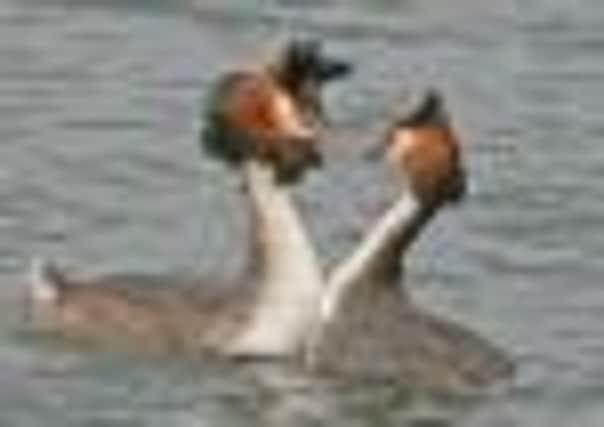Birdwatch: Grebes put on a show to remember


A potential pair will swim up and face each other throughout a sequence of complex neck-swaying, head shaking and bill touching, all in perfect symmetry, and with the beautiful black and chestnut plumes raised.
One of the birds may dive, then rise slowly from the water, with neck stretched and head bowed forward, towards its partner.
Advertisement
Hide AdAdvertisement
Hide AdOne of the best known of the rituals is the weed dance where both birds dive, fill their beaks with pond weed, then rise to the surface and rapidly tread water with necks craned and breasts pressed together.
Both birds accompany their displays by making curious clicking noises.
Once this elaborate display has established the pair bond, a nest is built, little more than a floating head of reeds and other vegetation anchored to underwater plants.
The four or five eggs laid in the nest are white at first but quickly become stained as the nest vegetation rots.
Advertisement
Hide AdAdvertisement
Hide AdOnce the young are hatched, they often ride on their parents’ backs for a few weeks to keep them out of the reach of pike.
They are fed whole fish along with small feathers which form a lining in their stomachs as protection against fish bones.
Great crested grebes are one of this country’s favourite birds with at least 6,000 breeding pairs.
But once they faced extinction in this country.
In the 19th century, great crested grebe plumes and grebe ‘fur’, the dense body plumage, were much sought after for use in hats, muffs and boas, and by 1860, there were fewer than 100 birds left.
Advertisement
Hide AdAdvertisement
Hide AdBut wildlife legislation gave the birds extra protection and by the 1930s the population was back to around 1,200 pairs and the future assured.
The other most common grebe in this country, the little grebe, is also becoming more obvious now with its loud whinnying call heard coming from reedbeds.
The male and female face each other singing duets and stretching their necks while, like their large relative, they also exchange presents of pond weed.
Their courtship is noisier because they spend much more of their lives in the reeds where sound counts much more than an elaborate visual display.
Advertisement
Hide AdAdvertisement
Hide AdA rarer grebe, a Slavonian, is at Swillington Ings, near Leeds, while another was in North Bay, Scarborough.
Whooper swans are starting the journey back to Icelandic breeding grounds, with parties seen across the region, including 60 at Hatfield Moors, South Yorkshire, and 50 at the Nosterfield Nature reserve, North Yorkshire. A drake smew and shore lark have also been seen there.
Mediterranean gulls, coming into full breeding plumage of black hood and thick, bright red bill, have been seen at Nosterfield, Astley Lake, Leeds, and the RSPB’s Old Moor reserve, near Barnsley, while two or three are still being seen around the Holbeck Hall car park, at Scarborough.
Long-eared owls are still present at Blacktoft Sands and Fairburn Ings, where a barn owl is also being seen.
Advertisement
Hide AdAdvertisement
Hide AdA large flock of lesser and mealy redpolls is still being seen at Fairburn Ings.
A grey plover, bar-tailed godwit, 20 ruff and 90 dunlin are among birds seen from the Thorganby Ings viewing platform, in the Lower Derwent, valley between York and Selby.
Three common cranes were seen over Thorne Moors, South Yorkshire.